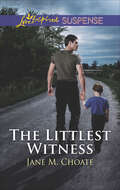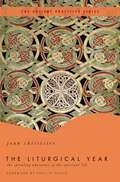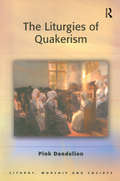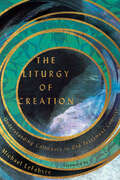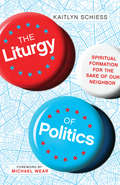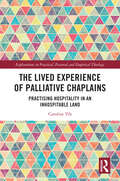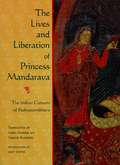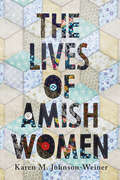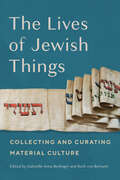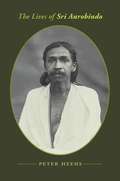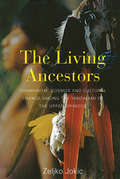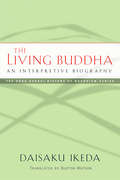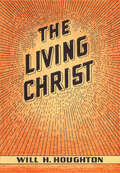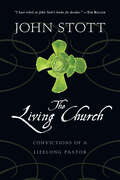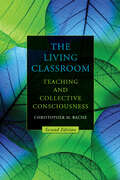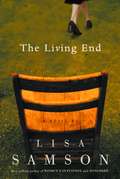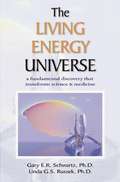- Table View
- List View
The Littlest Witness
by Jane M. ChoateA soldier and a Secret Service agent join forces to protect an orphan from his parents’ killers in this inspirational romantic suspense tale.When Delta Force soldier Caleb Judd’s brother and sister-in-law are murdered, the killers turn their attention on his orphaned nephew. Caleb’s new mission: protect little Tommy—who hasn’t said a word since witnessing his parents’ deaths—and figure out who’s targeting his family. He needs help, and security expert Shelley Rabb is perfect for the job. But Caleb’s used to calling the shots, not taking orders . . . even when they come from a beautiful former Secret Service agent. Shelley knows firsthand what can happen when business becomes personal, so she vows not to get too close to Caleb and his nephew. She will risk her life to make sure they’re safe, but will that mean risking her heart, too?Praise for The Littlest Witness“Choate’s latest is full of palpable emotions and dangerous twists. The characters demonstrate that life is rarely smooth and easy, but is instead full of numerous turns—just like the book.” —RT Book Reviews
The Liturgical Year: The Spiraling Adventure of the Spiritual Life - The Ancient Practices Series
by Joan ChittisterA journey of the soul through the map of Christian time.The liturgical year, beginning on the first Sunday of Advent and carrying through the following November is the year that sets out to attune the life of the Christian to the life of Jesus, the Christ. This book sets out to open what may at first seem to be simply an arbitrary arrangement of ancient holy days or liturgical seasons to their essential relationship to one another and their ongoing meaning to us today. It is an excursion into life from the Christian perspective, from the viewpoint of those who set out not only to follow Jesus but to live as Jesus lived and to think as Jesus thought.It proposes, year after year, to immerse us over and over again into the sense and substance of the Christian life until, eventually, we become what we say we are-followers of Jesus all the way to the heart of God. It is an adventure in human growth; it is an exercise in spiritual ripening.
The Liturgies of Quakerism (Liturgy, Worship and Society Series)
by Pink DandelionThe Liturgies of Quakerism explores the nature of liturgy within a form of worship based in silence. Tracing the original seventeenth century Quakers' understanding of the 'liturgy of silence', and what for them replaced the outward forms used in other parts of Christianity, this book explains how early Quaker understandings of 'time', 'history', and 'apocalyptic' led to an inward liturgical form. The practices and understanding of twenty-first century Liberal Quakers are explored, showing that these contemporary Quakers maintain the same kind of liturgical form as their ancestors and yet understand it in a very different way. Breaking new ground in the study of Quaker liturgy, this book contrasts the two periods and looks at some of the consequences for the study of liturgy in general, and Quakerism in particular. It also explores evangelical Quaker understandings of liturgy.
The Liturgy Explained
by James W. FarwellAn easy-to-understand explanation of the liturgy in all its aspects for the uninitiated. In this clear and concise work, respected liturgical theologian James W. Farwell provides a basic introduction to the liturgy of the Episcopal Church. He explains what happens when and why in straightforward terms for newcomers who have no prior knowledge of liturgical matters. The Liturgy Explained will be immensely edifying for veteran worshippers in the Episcopal Church.
The Liturgy in Medieval England
by Richard W. PfaffThis is the first comprehensive historical treatment of the Latin liturgy in medieval England. Richard Pfaff constructs a history of the worship carried out in churches - cathedral, monastic, or parish - primarily through the surviving manuscripts of service books, and sets this within the context of the wider political, ecclesiastical, and cultural history of the period. The main focus is on the mass and daily office, treated both chronologically and by type, the liturgies of each religious order and each secular 'use' being studied individually. Furthermore, hagiographical and historiographical themes - respectively, which saints are prominent in a given witness and how the labors of scholars over the last century and a half have both furthered and, in some cases, impeded our understandings - are explored throughout. The book thus provides both a narrative account and a reference tool of permanent value.
The Liturgy of Creation: Understanding Calendars in Old Testament Context
by Michael LeFebvreHolidays today are often established by legislation, and calendars are published on paper and smart phones. But how were holidays chosen and taught in biblical Israel? And what might these holidays have to do with the creation narrative? In this book, Michael LeFebvre considers the calendars of the Pentateuch with their basis in the heavenly lights and the land's agricultural cadences. He argues that dates were added to Old Testament narratives not as journalistic details but to teach sacred rhythms of labor and worship. LeFebvre then applies this insight to the creation week, finding that the days of creation also serve a liturgical purpose and not a scientific one. The Liturgy of Creation restores emphasis on the religious function of the creation week as a guide for Sabbath worship. Scholars, students, and church members alike will appreciate LeFebvre's careful scholarship and pastoral sensibilities.
The Liturgy of Politics: Spiritual Formation for the Sake of Our Neighbor
by Kaitlyn SchiessA generation of young Christians are weary of the political legacy they've inherited and hungry for a better approach. They're tired of seeing their faith tied to political battles they didn't start, and they're frustrated by the failures of leaders they thought they could trust. Kaitlyn Schiess grew up in this landscape, and understands it from the inside. Spiritual formation, and particularly a focus on formative practices, are experiencing a renaissance in Christian thinking—but these ideas are not often applied to the political sphere. In The Liturgy of Politics, Schiess shows that the church's politics are shaped by its habits and practices even when it's unaware of them. Schiess insists that the way out of our political morass is first to recognize the formative power of the political forces all around us, and then to recover historic Christian practices that shape us according to the truth of the gospel.
The Lived Experience of Palliative Chaplains: Practising Hospitality in an Inhospitable Land (Explorations in Practical, Pastoral and Empirical Theology)
by Caroline YihThis book explores the unique challenges of disenfranchisement faced by Christian chaplains working within the secular and pluralistic context of contemporary healthcare. The case study focuses on practitioners in Hong Kong and showcases the utilisation of interpretative phenomenological analysis (IPA) as a fruitful basis for practical theological endeavours. The role and perspective of the palliative chaplain as spiritual care specialist is examined, along with the tension that exists with the cultural and organisational context in which they operate. The chapters examine how end of life care practitioners can often face marginalisation, oppression, vulnerability, and disorientation among other difficult experiences that the author unites under a general theme of “homelessness”. The book contributes to discussions regarding fuller integration of the spiritual dimension within a holistic vision of end of life care provision. It will be of particular interest to scholars of practical theology and chaplaincy, as well as palliative medicine.
The Lively Arts of Sister Gervaise
by John L. BonnThis is an entertaining novelette depicting the interior and exterior trials and tribulations of a sensitive, cultivated and "daring" nun in charge of dramatics at St. Rita's parish high school. Sister Gervaise is a zealous religious, who understands young people's problems, focuses on the essentials in matters of religion and education rather than fussing about accidentals, insists upon liturgical music's supplanting the customary sentimental hymns and prefers staging the plays of Ghéon and T. S. Eliot to producing a parish minstrel show. Her propensities do not sit well with the pastor, some of the other nuns, the janitor, and some parents of the children who attend the school, and they involve her in difficulties as she attempts to "buck" the personalities that count and the customs that have prevailed in the life of the parish. At the end of the novel, just when things look blackest and she is about to be transferred to a college, her mandate of transfer is rescinded at the behest of pastor and people, who have belatedly come to appreciate her worth. The author paints faithful portraits of a number of typical personalities and customs in the average American Catholic convent and parish. Strictly a novel in form, no explicit moral is drawn from the story, but the reader may detect that the author is implicitly paying a tribute to the American Catholic Sisterhood working in the Catholic schools and good-naturedly deploring the lack of refined sensibilities in some of the personalities dominant in the life of the average American Catholic parish.
The Lives We Actually Have: 100 Blessings for Imperfect Days
by Kate Bowler Jessica RichieWarm and witty blessings found within the struggles of our shared humanity, from the New York Times bestselling authors of Good EnoughBlessed are you, the strange duck.You with the very intense hobbies.Or the collection of movies or mugs or sneakers.You with the hometown or home team that makes you very, very proud.You, my dear, in all your intricacies . . . are a marvel.We live in a world that demands relentless perfection. Happy marriages and easy friendships. Bucket list–level adventures and matching family photos. But what if our actual lives don&’t feel very #blessed? Might our everyday existence be worthy of a blessing too? Even an average Tuesday?Kate Bowler and Jessica Richie offer creative, faith-based blessings that center gratitude and hope while acknowledging our real, messy lives. Formatted like a prayer book, The Lives We Actually Have is an oasis and a landing spot for weary souls, with blessings that focus on the full range of human moments: garbage days, lovely days, grief-stricken days, and even (especially) completely ordinary days. These heartfelt blessings are a chance to exhale when we feel everything from careworn to restless, devastated to bored. Let&’s have a reminder that we don&’t need to wait for perfect lives when we can bless the lives we actually have.
The Lives and Liberation of Princess Mandarava
by Sangye Khandro Janet Gyatso Lama ChonamThis lucid translation of a rare Tibetan text makes available for the first time to Western readers the remarkable life story of Princess Madarava. As the principal consort of the eighth century Indian master Padmasambhava before he introduced tantric Buddhism to Tibet, Mandarava is the Indian counterpart of the Tibetan consort Yeshe Tsogyal. Lives and Liberation recounts her struggles and triumphs as a Buddhist adept throughout her many lives and is an authentic deliverance story of a female Buddhist master. Those who read this book will gain inspiration and encouragement on the path to liberation.
The Lives of Amish Women (Young Center Books in Anabaptist and Pietist Studies)
by Karen M. Johnson-WeinerPresenting a challenge to popular stereotypes, this book is an intimate exploration of the religiously defined roles of Amish women and how these roles have changed over time.Continuity and change, tradition and dynamism shape the lives of Amish women and make their experiences both distinctive and diverse. On the one hand, a principled commitment to living Old Order lives, purposely out of step with the cultural mainstream, has provided Amish women with a good deal of constancy. Even in relatively more progressive Amish communities, women still engage in activities common to their counterparts in earlier times: gardening, homemaking, and childrearing. On the other hand, these persistent themes of domestic labor and the responsibilities of motherhood have been affected by profound social, economic, and technological changes up through the twenty-first century, shaping Amish women's lives in different ways and resulting in increasingly varied experiences.In The Lives of Amish Women, Karen M. Johnson-Weiner draws on her thirty-five years of fieldwork in Amish communities and her correspondence with Amish women to consider how the religiously defined roles of Amish women have changed as Amish churches have evolved. Looking in particular at women's lives and activities at different ages and in different communities, Johnson-Weiner explores the relationship between changing patterns of social and economic interaction with mainstream society and women's family, community, and church roles. What does it mean, Johnson-Weiner asks, for an Amish woman to be humble when she is the owner of a business that serves people internationally? Is a childless Amish woman or a single Amish woman still a "Keeper at Home" in the same way as a woman raising a family? What does Gelassenheit—giving oneself up to God's will—mean in a subsistence-level agrarian Amish community, and is it at all comparable to what it means in a wealthy settlement where some members may be millionaires?Illuminating the key role Amish women play in maintaining the spiritual and economic health of their church communities, this wide-ranging book touches on a number of topics, including early Anabaptist women and Amish pioneers to North America; stages of life; marriage and family; events that bring women together; women as breadwinners; women who do not meet the Amish norm (single women, childless women, widows); and even what books Amish women are reading. Aimed at anyone who is interested in the Amish experience, The Lives of Amish Women will help readers understand better the costs and benefits of being an Amish woman in a modern world and will challenge the stereotypes, myths, and imaginative fictions about Amish women that have shaped how they are viewed by mainstream society.
The Lives of Jewish Things: Collecting and Curating Material Culture (Raphael Patai Series in Jewish Folklore and Anthropology)
by Ruth Von Bernuth Gabrielle Anna BerlingerExploring the people and contexts that imbue Jewish material culture with its meaning. In museums, synagogues, antique stores, and personal collections, Jewish objects are gathered, studied, and passed down as material representations of a culture and faith. What defines these items as "Jewish," and how does an item acquire or lose this characteristic throughout its life? Drawing from material culture studies, folklore studies, and curatorial perspectives, this collection aims to answer these questions and reveal the life histories of Jewish things. Essays consider assemblages ranging from Holocaust ephemera to religious relics and pieces of art. Each time these materials cross geographic, cultural, or social borders, their Jewishness is redefined through new dialogues about maker and user, buyer and seller, insider and outsider. Each contributor's insight builds bridges between curators, private collectors, scholars, and archivists whose diverse perspectives inform a growing conversation in folklore, religion, and Jewish studies that places material culture at the heart of Jewish cultural and historical narratives. Tracing the paths of Jewish things across time, place, and culture, this collection reveals complex stories of individual and collective struggles to survive.
The Lives of Muhammad
by Kecia AliKecia Ali delves into the many ways the Prophet's life story has been told from the earliest days of Islam to the present, by both Muslims and non-Muslims. Emphasizing the major transformations since the nineteenth century, she shows that far from being mutually opposed, these various perspectives have become increasingly interdependent.
The Lives of Objects: Material Culture, Experience, and the Real in the History of Early Christianity (Class 200: New Studies in Religion)
by Maia KotrositsOur lives are filled with objects—ones that we carry with us, that define our homes, that serve practical purposes, and that hold sentimental value. When they are broken, lost, left behind, or removed from their context, they can feel alien, take on a different use, or become trash. The lives of objects change when our relationships to them change. Maia Kotrosits offers a fresh perspective on objects, looking beyond physical material to consider how collective imagination shapes the formation of objects and the experience of reality. Bringing a psychoanalytic approach to the analysis of material culture, she examines objects of attachment—relationships, ideas, and beliefs that live on in the psyche—and illustrates how people across time have anchored value systems to the materiality of life. Engaging with classical studies, history, anthropology, and literary, gender, and queer studies, Kotrosits shows how these disciplines address historical knowledge and how an expanded definition of materiality can help us make connections between antiquity and the contemporary world.
The Lives of Sri Aurobindo
by Peter HeehsSince his death in 1950, Sri Aurobindo Ghose has been known primarily as a yogi and a philosopher of spiritual evolution who was nominated for the Nobel Prize in peace and literature. But the years Aurobindo spent in yogic retirement were preceded by nearly four decades of rich public and intellectual work. Biographers usually focus solely on Aurobindo's life as a politician or sage, but he was also a scholar, a revolutionary, a poet, a philosopher, a social and cultural theorist, and the inspiration for an experiment in communal living.Peter Heehs, one of the founders of the Sri Aurobindo Ashram Archives, is the first to relate all the aspects of Aurobindo's life in its entirety. Consulting rare primary sources, Heehs describes the leader's role in the freedom movement and in the framing of modern Indian spirituality. He examines the thinker's literary, cultural, and sociological writings and the Sanskrit, Bengali, English, and French literature that influenced them, and he finds the foundations of Aurobindo's yoga practice in his diaries and unpublished letters. Heehs's biography is a sensitive, honest portrait of a life that also provides surprising insights into twentieth-century Indian history.
The Living Ancestors: Shamanism, Cosmos and Cultural Change among the Yanomami of the Upper Orinoco
by Zeljko JokicThis phenomenologically oriented ethnography focuses on experiential aspects of Yanomami shamanism, including shamanistic activities in the context of cultural change. The author interweaves ethnographic material with theoretical components of a holographic principle, or the idea that the “part is equal to the whole,” which is embedded in the nature of the Yanomami macrocosm, human dwelling, multiple-soul components, and shamans’ relationships with embodied spirit-helpers. This book fills an important gap in the regional study of Yanomami people, and, on a broader scale, enriches understanding of this ancient phenomenon by focusing on the consciousness involved in shamanism through firsthand experiential involvement.
The Living Buddha: An Interpretive Biography (Soka Gakkai History of Buddhism)
by Burton Watson Daisaku IkedaAn intimate portrayal of one of history’s most important and obscure figures, the Buddha, this chronicle reveals him not as a mystic, but a warm and engaged human being that was very much the product of his turbulent times. This biographical account traces the path of Siddhartha Gautama as he walked away from the pleasure palace that had been his home and joined a growing force of wandering monks, ultimately making his way towards enlightenment beneath the bodhi tree, and spending the next 45 years sharing his insights along the banks of the Ganges. The Buddhist canon is expertly harvested to provide insight into the Buddha’s inner life and to grant a better understanding of how he came to play his pivotal role as founder of one of the world’s largest religions.
The Living Christ
by Harold FickettIs Jesus’ promise to live on through his believers true? Can we find the living Christ in today’s complicated, uneasy world? Harold Fickett explores these questions in The Living Christ, a journey throughout the world in search of individual Christians whose daily lives reflect different aspects of the resurrected Christ. Fickett profiles a woman who rescues girls from prostitution in Thailand, a “trucker chaplain” in South Carolina, a visionary living on the California coast, an America priest who con...
The Living Christ: And Other Gospel Messages
by Will H HoughtonNine important messages, written in the author's friendly style, are embraced in this volume. The title of the book is taken from the first message, which is of such great import in these days when so many are worshipping a dead Christ. The Living Christ has a vital appeal to the young as well as to the old. It emphasizes the need and the way of salvation. In the chapter entitled "Your Permanent Writing," the author stresses the importance of character, showing how character is formed by habits--good or bad--and becomes permanent. Some day it will be revealed! Dr. Houghton turns the "Stop Light" across life's pathway, for he is a friend of young people, and points them the better way.
The Living Christ: And Other Gospel Messages
by Will H HoughtonNine important messages, written in the author's friendly style, are embraced in this volume. The title of the book is taken from the first message, which is of such great import in these days when so many are worshipping a dead Christ. The Living Christ has a vital appeal to the young as well as to the old. It emphasizes the need and the way of salvation. In the chapter entitled "Your Permanent Writing," the author stresses the importance of character, showing how character is formed by habits--good or bad--and becomes permanent. Some day it will be revealed! Dr. Houghton turns the "Stop Light" across life's pathway, for he is a friend of young people, and points them the better way.
The Living Church: Convictions of a Lifelong Pastor
by John Stott. . . a biblical church. . . a worshiping church. . . a caring church. . . a serving church. . . an expectant church
The Living Classroom, Second Edition: Teaching and Collective Consciousness
by Christopher M. BacheA pioneering work in teaching and transpersonal psychology, The Living Classroom explores the dynamics of collective consciousness in the classroom. In this second edition, Bache has, in his own words, "come out of the psychedelic closet," speaking candidly about the role that psychedelics played in the development of his integral, holistic pedagogy. Combining scientific research with personal accounts collected over thirty years, Bache examines the subtle influences that radiate invisibly around teachers as they work—unintended, cognitive resonances that spring up between teachers and students in the classroom. While these kinds of synchronistic connections are often overlooked by traditional academics, Bache demonstrates that they occur too frequently and are too pointed to be dismissed as mere coincidence. Drawing upon Rupert Sheldrake's theory of morphic fields, Bache proposes that well-taught courses generate "learning fields" around them, forms of collective consciousness that can trigger new insights and startling personal transformations. Moving beyond theory, this book is rich with student stories and offers practical, hands-on strategies for teachers who want to begin working with these learning fields to take their teaching to a more conscious level.
The Living End
by Lisa SamsonOne Last Goodbye. One Last Adventure. Pearly Laurel is devastated by the death of her beloved husband of thirty-five years. The two had always said they couldn't live without one another, and Pearly has no desire to even try. Then, in the midst of her grief, Pearly finds a tattered list in Joey's pocket, entitled, While I Live, I Want toa. o His ultimate to-do list sends her off on a mission to accomplish Joey's last unfulfilled goalsualong with a few of her ownubefore arranging her own death. But the people she meets along the way have something else in mind. Can their unexpected gifts, secrets long hidden in Joey's journal, and memories from the rich life they shared convince Pearly that, despite her pain and grief, life is still worth living?
The Living Energy Universe: A Fundament Discovery Transforms Science and Medicine
by Gary E. Schwartz Linda G. S. RussekThis book presents the idea that everything, at every level of existence, is alive, remembers, and evolves. Schwartz and Russek's systemic memory hypothesis is proposed to explain not only many puzzles in conventional science, but also major mysteries such as reflective self-awareness, homeopathy, survival after death, and psychic abilities. These authors gives serious consideration of these latter topics with a enthusiastic writing style.
